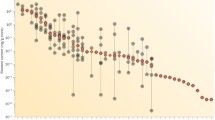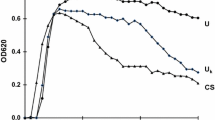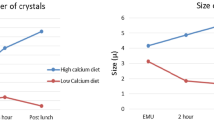Summary
Naturally occurring glycosaminoglycans (GAGs) and other, semisynthetic, sulphated polysaccharides are thought to play an important role in urolithiasis. Processes involved in urinary stone formation are crystallization and crystal retention. Oxalate transport and renal tubular cell injury are determining factors in these processes. In this article experimental results concerning the possible mechanisms of action of GAGs and other sulphated polysaccharides are reviewed. GAGs are inhibitors of crystal growth and agglomeration and possibly also of nucleation. They can prevent crystal adherence, correct an abnormal oxalate flux and prevent renal tubular cell damage.
Similar content being viewed by others
References
Angell AH, Resnick MI (1989) Surface interaction between glycosaminoglycans and calcium oxalate. J Urol 141:1255–1258
Baggio B, Gambaro G, Ossi E, Favaro S, Borsati A (1983) Increased urinary excretion of renal enzymes in idiopathic calcium oxalate nephrolithiasis. J Urol 129:1161–1162
Baggio B, Gambaro G, Marchini F, Cicerello E, Tenconi R, Clementi M, Borsati A (1986) An inheritable anomaly of red-cell oxalate transport in “primary” calcium nephrolithiasis correctable with diuretics. N Engl J Med 314:599–604
Baggio B, Gambaro G, Marchini F, Marzaro G, Williams HE, Borsati A (1991) Correction of erythrocyte abnormalities in idiopathic calcium-oxalate nephrolithiasis and reduction of urinary oxalate by oral glycosaminoglycans. Lancet 338:403–405
Bek-Jensen H, Tiselius HG (1991) Inhibition of calcium oxalate crystallization by urinary macromolecules. Urol Res 19:165–169
Boevé ER, Cao LC, Schröder FH, Ketelaars GAM, Vermey M, Bruijn WC de (1990) The influence of 3 exogenous glycosaminoglycans on the experimental induction of microliths in rats. Urol Res 18:62
Boevé ER, Cao LC, Bruijn WC de, Robertson WG, Schröder FH (1993) The effect of two semi-synthetic glycosaminoglycans (G871, G872) on the zeta potential of calcium phosphate crystals and on growth and agglomeration. J Urol 149:441A
Boevé ER, Ketelaars GAM, Vermeij M, Cao LC, Schröder FH, Bruijn WC de (1993) An ultrastructural study of experimentally induced microliths in rat proximal and distal tubules. J Urol 149:893–899
Bowyer RC, Brockis JG, McCulloch RK (1979) Glycosaminoglycans as inhibitors of calcium oxalate crystal growth and aggregation. Clin Chim Acta 95:23–28
Bruijn WC de, Ketelaars GAM, Boevé ER, Sorber CWJ, Cao LC, Schröder FH (1993) Electron energy-loss spectroscopical and image analysis of experimentally induced rat mocroliths. J Urol 149:900–905
Butt AJ (1952) Role of protective urinary colloids in prevention of lithiasis. J Urol 67:450–459
Cao LC, Boevé ER, Schröder FH (1991) The mechanisms of action of glycosaminoglycans (GAGs) in calcium oxalate stone prevention: a review. J Lithotripsy Stone Dis 3:324–333
Cao LC, Boevé ER, Schröder FH, Robertson WG, Ketelaars GAM, Bruijn WC de (1992) The effect of two new semi-synthetic glycosaminoglycans (G871, G872) on the zeta potential of calcium oxalate crystals and on growth and agglomeration. J Urol 147:1643–1646
Caudarella R, Stefani F, Rizzoli E, Malavolta N, D'Antuono G (1983) Preliminary results of glycosaminoglycan excretion in normal and stone forming subjects: relationship with uric acid excretion. J Urol 129:665–667
Danielson BG, Fellström B, Wikström B (1989) Glycosaminoglycans as inhibitors of renal stone formation. In: Walker VR, Sutton RAL, Cameron ECB, Pak CYC, Robertson WG (eds). Urolithiasis. Plenum, New York, pp 101–104
Dawes J, Hodson BA, Pepper DS (1989) The absorption, clearance and metabolic fate of dermatan sulphate administerd to man — studies using a radioiodinated derivative. Thromb Haemos 62:945–949
DiFerrante N, Rich C (1956) The determination of acid aminopolysaccharide in urine. J Lab Clin Med 48:491–494
Drach GW, Sarig S, Randolph AD, Thorson S (1982) The paradox of inhibition and enhancement of the formation of urinary stones. Urol Res 10:165–168
Fellström B, Danielson BG, Ljunghall S, Wikström B (1985) The inhibition of calcium oxalate crystal growth by chondroitin sulphates, heparin, pentosan polysulphate and Tamm-Horsfall glycoprotein. In: Schwille PO, Smith LH, Robertson WG, Vahlensieck W (eds) Urolithiasis and related clinical research. Plenum, New York, pp 887–890
Fellström B, Lindsjö M, Danielson BG, Ljunghall S, Wikström B (1986) Binding of glycosaminoglycans to sodium urate and uric acid crystals. Clin Sci 71:61–64
Fellström B, Lindsjö M, Danielson BG, Karlsson FA, Ljunghall S (1989) Binding of glycosaminoglycan inhibitors to calcium oxalate crystals in relation to ionic strength. Clin Chim Acta 180:213–220
Finlayson B, Du Bois L (1978) Adsorption of heparin on sodium acid urate. Clin Chim Acta 84:203–206
Finlayson B, Khan SR, Hackett RL (1984) Mechanisms of stone formation — an overview. Scan Microsc Int 3:1419–1425
Gambaro G, Cavazzana AO, Luzi P, Piccoli A, Borsati A, Crepaldi G, Marchi E, Venturini AP, Baggio B (1992) Glycosaminoglycans prevent morphological renal alterations and albuminuria in diabetic rats. Kidney Int 42:285–291
Gianotti M, Genestar C, Palou A, Pons A, Conte A, Grases F (1989) Investigation of GAGs on 24-hour and 2-hour urines from calcium oxalate stone formers and healthy subjects. Int Urol Nephrol 21:281–288
Gill WB, Ruggiero KJ, Straus FH (1980) Crystallization studies in an urothelial-lined living test tube (the catheterized female rat bladder). I. Calcium oxalate crystal adhesion to the chemically injured rat bladder. Invest Urol 17:259–261
Gill WB, Ruggiero KJ, Fromez MC (1980) Elevation of the metastable limits and absence of container surface nucleation for calcium oxalate crystallization in a urothelial-lined system as compared to glass containers. Invest Urol 18:158–160
Gill WB, Jones KW, Ruggiero KJ (1982) Protective effects of heparin and other sulfated glycosaminoglycans on crystal adhesion to injured urothelium. J Urol 127:152–154
Goldberg JM, Cotlier E (1972) Specific isolation and analysis of mucopolysaccharides (glycosaminoglycans) from human urine. Clin Chim Acta 41:19–27
Grases F, Costa-Bauzá A, March JG (1991) Glycosaminoglycans, uric acid and calcium oxalate urolithiasis. Urol Res 19:375–380
Grover PK, Ryall RL, Marshall VR (1992) Calcium oxalate crystallization in urine: role of urate and glycosaminoglycans. Kidney Int 41:149–154
Hansen NM, Felix R, Bisaz S, Fleisch H (1976) Aggregation of hydroxyapatite crystals. Biochim Biophys Acta 451:549–559
Hesse A, Wuzel H, Vahlensieck W (1986) The excretion of glycosaminoglycans in the urine of calcium-oxalate-stone patients and healthy persons. Urol Int 41:81–87
Hesse A, Wuzel H, Krampitz G, Vahlensieck W (1987) Experimental determination of the kinetics of calcium-binding with chondroitin sulphate and the effects of uric acid on this process. Urol Res 15:93–97
Hesse A, Wuzel H, Vahlensieck W (1991) Significance of glycosaminoglycans for the formation of calcium oxalate stones. Am J Kidney Dis 17:414–419
Khan SR, Shevock PN, Hackett RL (1992) Acute hyperoxaluria, renal injury and calcium oxalate urolithiasis. J Urol 147:226–230
Kerby GP (1954) The excretion of glucuronic acid and of acid mucopolysaccharides in normal human urine. J Clin Invest 33:1168–1174
Kohri K, Garside J, Blacklock NJ (1989) The effect of glycosaminoglycans on the crystallisation of calcium oxalate. Br J Urol 63:584–590
Kok DJ, Papapoulos SE, Blomen LJMJ, Bijvoet OLM (1988) Modulation of calcium oxalate monohydrate crystallization kinetics in vitro. Kidney Int 34:346–350
Kumar S, Sigmon D, Miller T, Carpenter B, Khan S, Malhotra R, Scheid C, Menon M (1991) A new model of nephrolithiasis involving tubular dysfunction/injury. J Urol 146:1384–1389
Leal JJ, Finlayson B (1977) Adsorption of naturally occurring polymers onto calcium oxalate crystal surfaces. Invest Urol 14:278–283
Lieske JC, Toback FG (1993) Regulation of renal epithelial cell endocytosis of calcium oxalate monohydrate crystals. Am J Physiol [F] 264:800–807
Mandel NS, Mandel GS, Hasegawa AT (1987) The effect of some urinary stone inhibitors on membrane interaction potentials of stone crystals. J Urol 138:557–562
Martin X, Werness PG, Bergert JH, Smith LH (1984) Pentosan polysulfate as an inhibitor of calcium oxalate crystal growth. J Urol 132:786–788
MacGregor IR, Dawes J, Paton L, Pepper DS, Prowse CV, Smith M (1984) Metabolism of sodium pentosan polysulphate in man — catabolism of iodinated derivatives. Thromb Haemost 51:321–325
McLean RJC, Downey J, Claphan L, Nickel JC (1990) Influence of chondroitin sulphate, heparin sulphate, and citrate on Proteus mirabilis-induced struvite crystallization in vitro. J Urol 144:1267–1271
Michelacci YM, Boim MA, Bergamaschi CT, Rovigatti RM, Schor N (1992) Possible role for chondroitin sulfate in urolithiasis: in vivo studies in an experimental model. Clin Chim Acta 208:1–8
Miyazawa K, Suzuki K, Tsugawa R (1991) A study of crystallization on urolithiasis in vitro (in Japanese). Hinyokika-kiyo 37:1091–1096
Monis B, Dorfman HD (1967) Some histochemical observations on transitional epithelium of man. J Histochem Cytochem 15:475–481
Newton DJ, Scott JE, Ahmad S (1979) Circadian rhythms and the urinary excretion of acid glycosaminoglycans in normal human adults. Connect Tissue Res 7:47–55
Norman RW, Scurr DS, Robertson WG, Peacock M (1984) Inhibition of calcium oxalate crystallization by pentosan polysulphate in control subjects and stone formers. Br J Urol 56:594–598
Norman RW, Scurr DS, Robertson WG, Peacock M (1985) Sodium pentosan polysulphate as a polyanionic inhibitor of calcium oxalate crystallization in vitro and in vivo. Clin Sci 68:369–371
Odlind L, Dencker L, Tengblad A (1987) Preferential localization of 3H-pentosanpolysulphate to the urinary tract in rats. Pharmacol Toxicol 61:162–166
Osswald H, Weinheimer G, Schütt ID, Ernst W (1989) Effective prevention of calcium-oxalate crystal formation in vitro and in vivo by pentosan polysulfate. In: Walker VR, Sutton RAL, Cameron ECB, Pak CYC, Robertson WG (eds) Urolithiasis. Plenum, New York, pp 141–144
Pantazopoulos D, Legakis N, Antonakopoulos G, Sofras F, Dimopoulos C (1987) The effect of pentosanpolysulphate and carbenoxolone on bacterial adherence to the injured urothelium. Br J Urol 59:423–426
Parsons CL (1982) Prevention of urinary tract infection by the exogenous glycosaminoglycan sodium pentosan polysulfate. J Urol 172:167–169
Parsons CL, Greenspan C, Moore SW, Mulholland SG (1977) Role of surface mucin in primary antibacterial defence of bladder. Urology 9:48–52
Parsons CL, Schmidt JD, Pollen JJ (1983) Successful treatment of interstitial cystitis with sodium pentosanpolysulphate. J Urol 130:51–53
Parsons CL, Danielson B, Fellström B (1985) Inhibition of sodium urate crystal adherence to bladder surface by polysaccharide. J Urol 134:614–616
Riese RJ, Mandel NS, Wiessner JH, Mandel GS, Becker CG, Kleinman JG (1992) Cell polarity and calcium oxalate crystal adherence to cultured collecting duct cells. Am J Physiol [F] 262:177–184
Robertson WG, Scurr DS (1986) Modifiers of calcium oxalate crystallization found in urine. I. Studies with a continuous crystallizer using an artificial urine. J Urol 135:1322–1326
Robertson WG, Peacock M, Nordin BEC (1973) Inhibitors of the growth and aggregation of calcium oxalate crystals in vitro. Clin Chim Acta 43:31–37
Robertson WG, Knowles F, Peacock M (1976) Urinary mucopolysaccharide inhibitors of calcium oxalate crystallization. In: Fleisch H, Robertson WG, Smith LH, Vahlensieck W (eds) Urolithiasis research. Plenum, New York London, pp 331–334
Robertson WG, Peacock M, Heyburn PJ, Marshall DH, Clark PB (1978) Risk factors in calcium stone disease of the urinary tract. Br J Urol 50:449–454
Ryall RL, Marshall VR (1983) The value of the 24-hour urine analysis in the assessment of stone-formers attending a general hospital outpatient clinic. Br J Urol 55:1–5
Ryall RL, Harnett RM, Marshall VR (1981) The effect of urine, pyrophosphate, citrate, magnesium and glycosaminoglycans on the growth and aggregation of calcium oxalate crystals in vitro. Clin Chim Acta 112:349–356
Ryall RL, Harnett RM, Marshall VR (1986) The effect of monosodium urate on the capacity of urine, chondroitin sulphate and heparin to inhibit calcium oxalate crystal growth and aggregation. J Urol 135:174–177
Sakhaee K, Nicar MJ, Brater DC, Pak CYC (1985) Exaggerated natri-uretic and calciuric responses to hydrochlorothiazide in renal hypercalciuria but not in absorptive hypercalciuria. J Clin Endocrinol Metab 61:825–829
Smith C (1985) 14C-Calcium oxalate (CaOx) adherence in the rat bladder. In: Schwille PO, Smith LH, Robertson WG, Vahlensieck W (eds) Urolithiasis and related clinical research. Plenum, New York, pp 949–952
Subha K, Varalakshmi P (1993) Alteration in some risk ractors and urinary enzymes in urolithiatic rats treated with sodium pentosan polysulphate. Biochem Mol Biol Int 29:271–280
Subha K, Varalakshmi P (1993) Changes in renal tissue glycosaminoglycans in urolithiatic rats treated with sodium pentosan polysulphate. Med Sci Res 21:233–234
Verkoelen CF, Romijn JC, Bruijn WC de, Boevé ER, Cao LC, Schröder FH (1993) Oxalate handling and interaction with calcium oxalate crystals by renal epithelial cells cultured on porous supports. J Urol 149:439A
Yamaguchi S, Yoshioka T, Utsunomiya M, Koide T, Osafune M, Okuyama A, Sonoda T (1993) Heparan sulfate in the stone matrix and its inhibitory effect on calcium oxalate crystallization. Urol Res 21:187–192
Author information
Authors and Affiliations
Rights and permissions
About this article
Cite this article
Boevé, E.R., Cao, L.C., Verkoelen, C.F. et al. Glycosaminoglycans and other sulphated polysaccharides in calculogenesis of urinary stones. World J Urol 12, 43–48 (1994). https://doi.org/10.1007/BF00182050
Issue Date:
DOI: https://doi.org/10.1007/BF00182050




